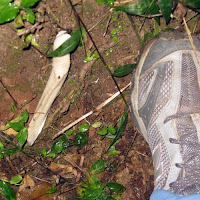When you hear someone in Rwanda say, “we must move beyond the tragedy of what happened here,” your thoughts immediately jump to the genocide. In the case of Gishwati forest, this statement refers to the massive deforestation that has taken place over the last 80 years, and the current optimism about conservation efforts. At one time, Gishwati stretched across a vast section of Western Rwanda and was home to chimpanzees and countless other plants and animals. Rwanda’s incredible population density has driven the deforestation, and by the 1980s much of the forest was either farmland or pastures for cows, which are very common in the region. (Upon returning to town, I was asked if I had brought back any milk.) Following the genocide, refugees from the Congo resettled in the area, further reducing the size of the forest.
Today, Gishwati has diminished to a sliver of its original grandeur. In addition to the smallholder farms and pastureland that have replaced centries-old trees, locals have planted eucalyptus groves both in the forest’s former footprint and inside the remaining forest. Eucalyptus is a non-native plant that’s fast-growing and highly profitable when converted into timber. For the desperately poor people in the surrounding district of Rutsiro, the remaining forest contains timber and other valuable resources, such as fruit for eating or bark for basket making. As the population continues to grow, people are sometimes at odds with the forest and its inhabitants: for example, chimps raiding nearby corn fields.
The deforestation has left a band of 13-15 chimps isolated from other forests in Rwanda. It has increased the already massive erosion problem in the area (landslides in the surrounding districts displaced hundreds earlier this year). Some say that conserving what remains of Gishwati is impossibly ambitious. However, the Great Ape Trust’s Forest of Hope project is working to reforest the area, study the chimps, increase local awareness of environment issues, and expand local livelihoods opportunities that would encourage a symbiotic rather than extractive relationship with the forest. According to the website, they’ve grown the area of the forest by 67% in less than three years. The people I met who work with Forest of Hope were a dedicated and talented bunch, and I'm optimistic on their behalf.
Here are some photos from my 7-kilometer hike through the forest.
Below left, a tree the forest was named for. Right, a tree stump which could probably serve as a parking spot for a small car.
This next picture has got to be a metaphor for something, but I'll leave that to your imaginations.
Like something out of science fiction, these giant ferns with poisonous thorns crowded the path in places. Left, the hazardous trunk, and right, a look up at the canopies.
This slug was so big it had its own bugs along for the ride. FYI, I wear a women's US7.5.
Shortly after we arrived at the waterfall, it started to pour: a welcome relief in the dry season.
The rain made me nervous about my camera (for a while I tucked it into the ziplock that had held my lunch) but it brought out this giant earthworm, maybe the coolest site of the hike.
In many spots the path passed charred remnants of charcoal production, one of the deforestation culprits.
We crossed several log bridges. Right, our guide and his scythe (used for trail cutting).
Several of these signs surround the forest to address the problem of locals using it as a toilet:
 It’s not allowed to defecate here
It’s not allowed to defecate hereDon’t destroy life
And the environment in general
If you are caught you will be punished
Finally, on the ride back north to Gisenyi I snapped a stereotypical "Land of a Thousand Hills" photo. The emerald blanket of tea in the foreground is common in much of northwestern Rwanda. The brown on the left has been recently harvested. The hills go on forever; no photo can do them justice.




















No comments:
Post a Comment